-
Heavy snow and blizzard on the Sea of ??Japan side, dry weather on the Pacific Ocean side, and be careful when handling fire.
2026/01/05 09:54
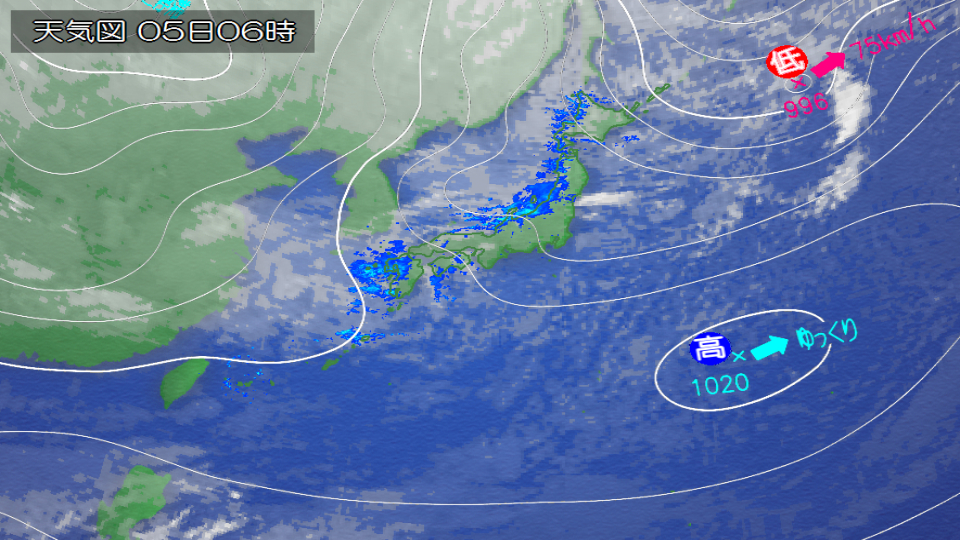
-
There is a developed low pressure system east of Kamchatka that is moving northeast.
There is also a low pressure system east of the Kuril Islands that is moving east.
On the other hand, high pressure is extending eastward from the continent, creating a winter-like atmospheric pressure pattern around Japan.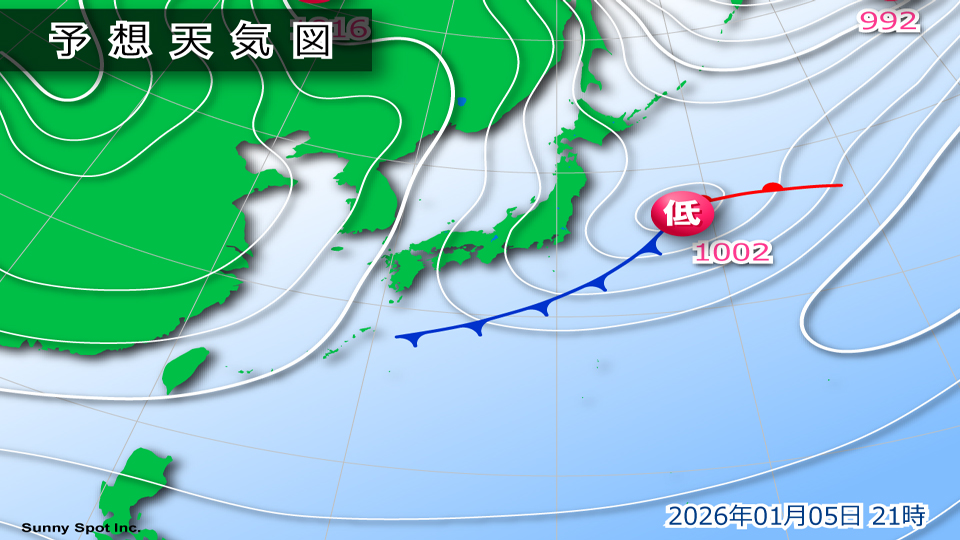
Currently, it is snowing and raining from Hokkaido to Hokuriku, and raining and snowing in Kyushu and Shikoku.
Today, the 5th (Monday), the winter-like pressure pattern is expected to intensify, and we will be affected by a trough of pressure accompanied by cold air of -30 degrees Celsius or less at an altitude of approximately 5,500 meters.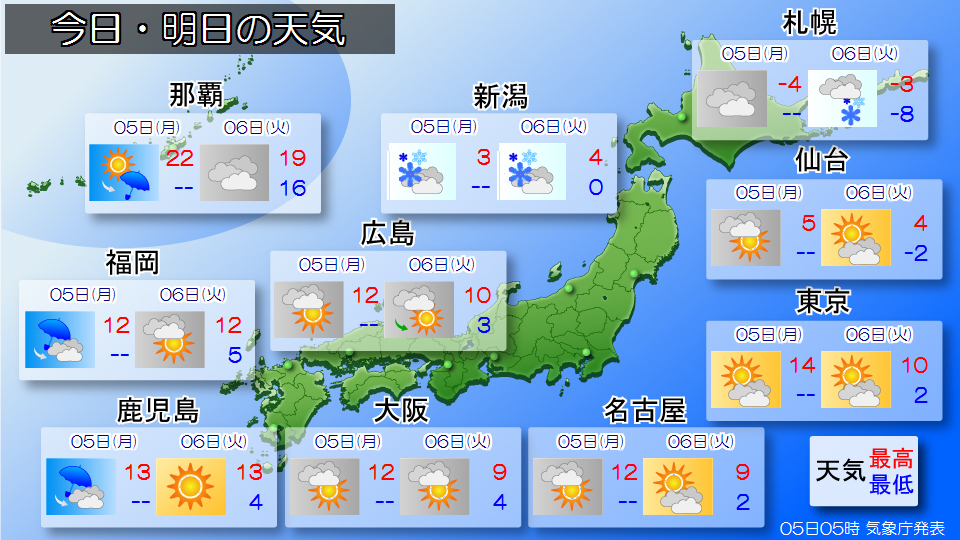
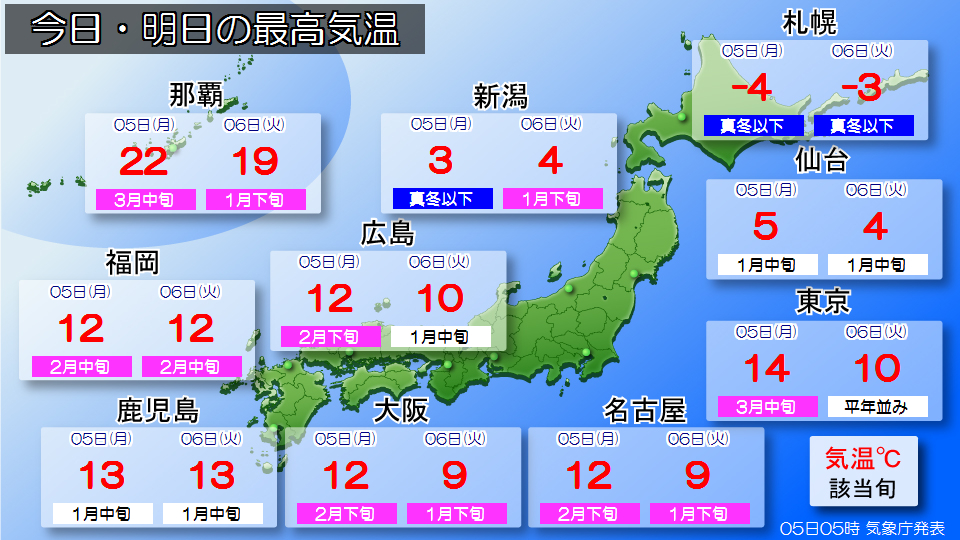
From Hokkaido to Hokuriku, there are many places on the Sea of Japan side where it snows and rains.
Please be aware that the atmospheric conditions in Tohoku and Hokuriku may become extremely unstable, leading to heavy snowfall accompanied by thunder.
Also, rain and snow are expected to fall in some places from the Kinki region to the Okinawa region due to the cold and humid air.
Although there are some places on the Pacific side of northern and eastern Japan, it will be sunny, but the air will remain dry. Please be careful when handling fire.
-
JPCZ will appear starting tonight. Start of work. What's the weather like this week [Weekly weather]
2026/01/04 11:54
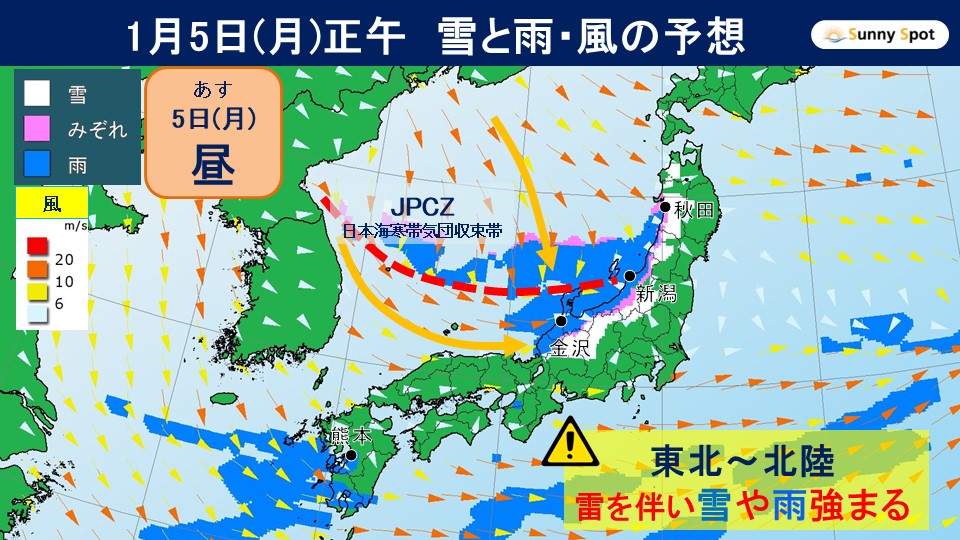
-
#Weather points for the next week#
5th (Monday) to 6th (Tuesday) JPCZ appears, heavy snow in Hokuriku and Tohoku
8th (Thursday) Low pressure develops, stormy weather is possible in northern and eastern Japan
10th (Sat) West time Intense cold air is flowing in, with the possibility of snow on the Pacific side
I'm sure many of you will be starting work tomorrow, January 5th (Monday), but let's take a closer look at the weather for the week after the New Year.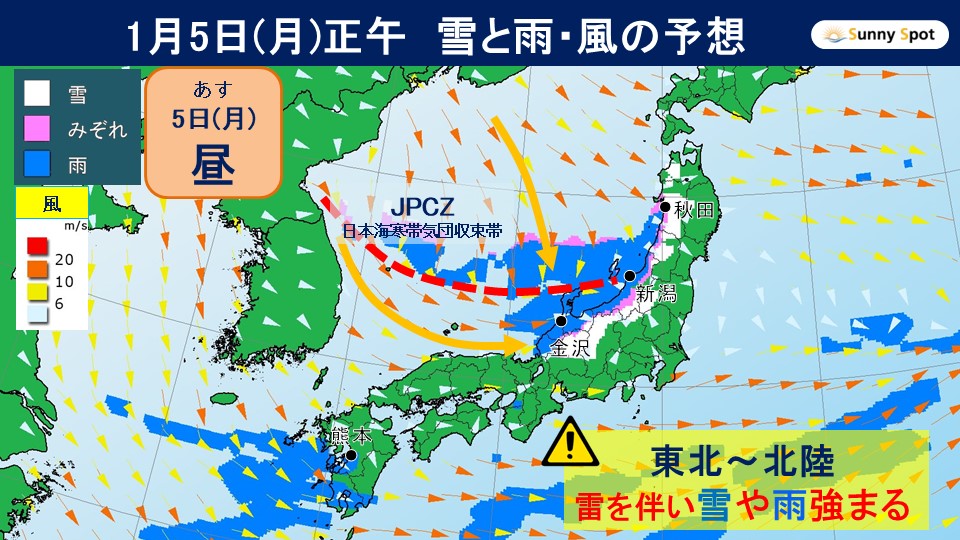
#Tomorrow 5th (Monday)#
From tonight to tomorrow 5th (Monday),
JPCZ (Japan Sea Polar Air Mass Convergence Zone) is expected to form in the Sea of Japan,
toward Tohoku and Hokuriku regions.
This JPCZ is a convergence zone created when
cold air currents (northern winds) are divided into two by a high mountain in the northern part of the Korean Peninsula,
and then merge again over the Sea of Japan.
Looking at the forecast for snow, rain, and wind at noon on the 5th (Monday) tomorrow,
the winds are colliding (converging) and forming band-shaped rain clouds over the Sea of Japan.
An active precipitation band will occur near this convergence zone, and
there is a possibility of increased snowfall along the mountains where this precipitation area falls.
Especially tomorrow, the 5th (Monday), there will be a lot of people moving around for work, but heavy snow and rain may affect
transportation in the Tohoku and Hokuriku areas.
Let's act with plenty of time.
In addition, small cyclones and disturbances occur over the JPCZ,
cumulonimbus clouds may develop, causing hail, lightning, and gusts of wind.
You must pay close attention to changes in the weather.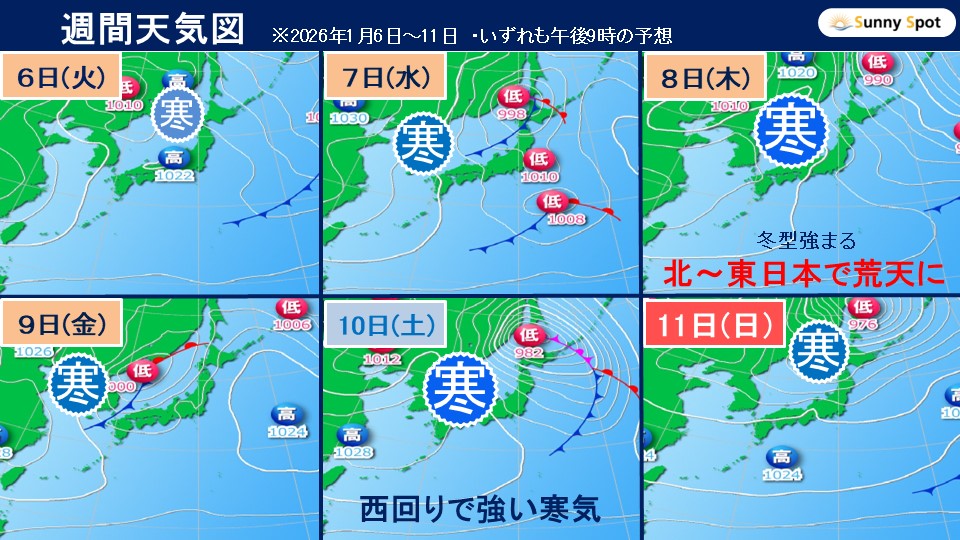
#6th (Tuesday)#
The vicinity of Honshu will gradually be covered by a mobile high pressure system, but
the sky over northern Japan will be covered by cold air.
Snow and rain will continue on the Japan Sea side, and there is a possibility of
warning-level heavy snow around Yamagata Prefecture.
On the other hand, it looks like there will be many places on the Pacific side where it will be mild and sunny.
#7th (Wednesday)#
A low pressure system accompanied by a front will pass near Japan, and
low pressure is also expected to form near the Kanto region.
Up until yesterday, the forecast was that there was a possibility of snow falling again in the Kanto region due to the strong influence of the low pressure near the Kanto region,
but the latest forecast shows that the area covered by snow clouds and rain clouds has narrowed, and the possibility of snow and rain falling in central Tokyo has decreased.
However, the trend and development of the low pressure system, as well as the forecast for cold air above
, may still change, so please continue to pay close attention to the latest information.
#8th (Thursday)#
A low pressure system will develop near the Sea of Okhotsk, and
a winter-like pressure pattern will become stronger near Japan.
There will be rough weather mainly on the Sea of Japan side of northern and eastern Japan, and depending on the degree of strengthening of the winter-type atmospheric pressure distribution, there is a risk of severe stormy weather.
There is a possibility of warning-level storms on the Sea of Japan side of northern Japan and Hokuriku, so please be careful about the impact on transportation.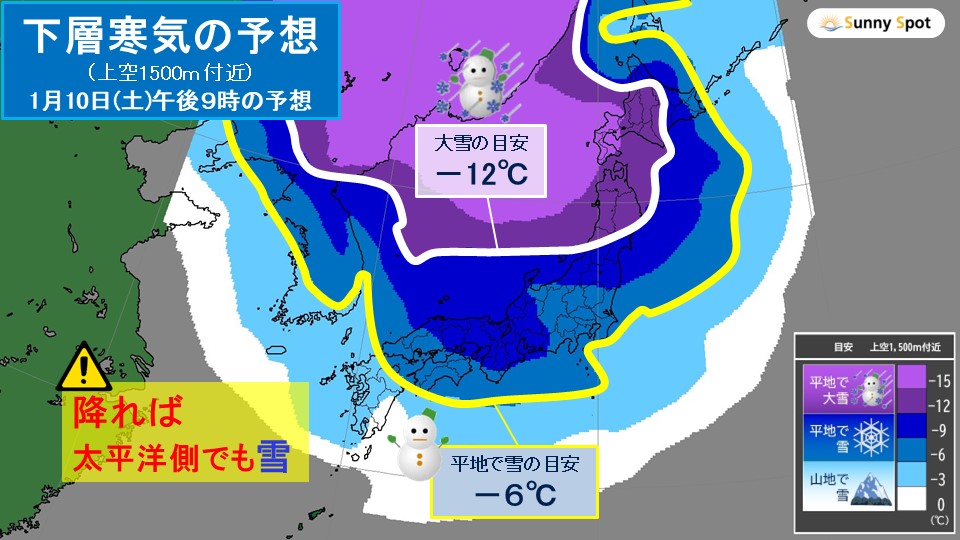
#9th (Friday) to 11th (Sunday)#
A new low pressure system has formed in the Sea of Japan, and is expected to continue to develop from
10th (Saturday) to 11th (Sunday) as it moves toward the Sakhalin area.
Especially around the 10th (Saturday), the winter-like pressure pattern will become stronger, and
strong cold air will flow in westward.
Snow is falling on the Pacific side of western and eastern Japan, and it seems that there will be some places where it will accumulate again on the flatlands.
During the first week of work, the weather has been changing rapidly,
the cold has become stronger and weaker, and
the temperature and sensation seem to change drastically from day to day.
Please check the latest weather frequently and take care of your health.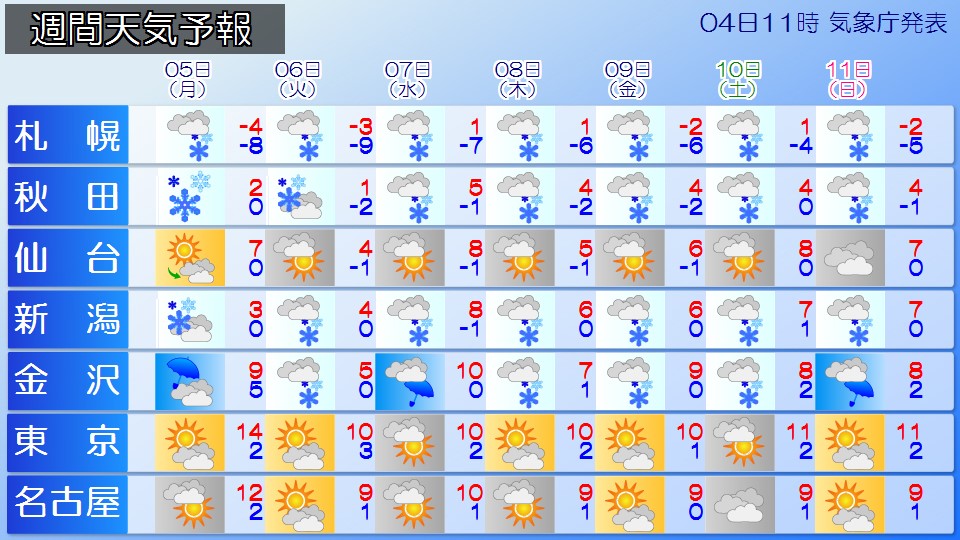
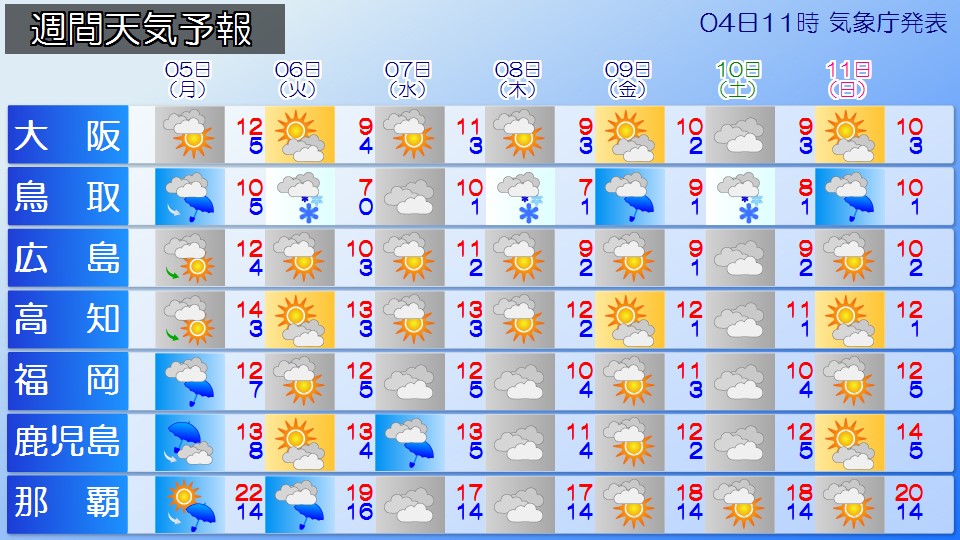
-
Weather for the week: Winter-like atmospheric pressure patterns continue; watch out for stormy weather in the second half of the week, especially on the Sea of Japan side
2026/01/04 09:11
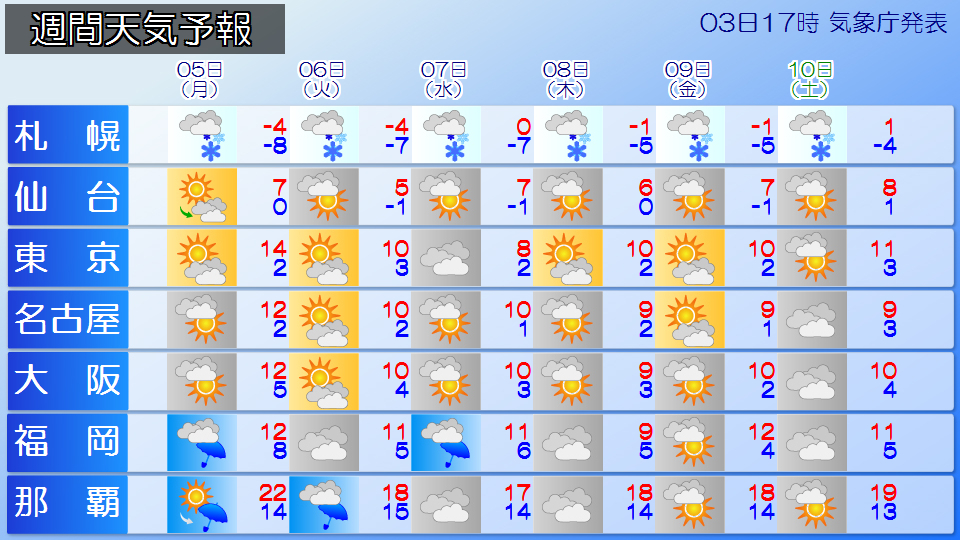
-
From now on, there is a possibility that winter-like pressure patterns will become stronger and the weather will become stormy due to the influence of a developing low pressure system.
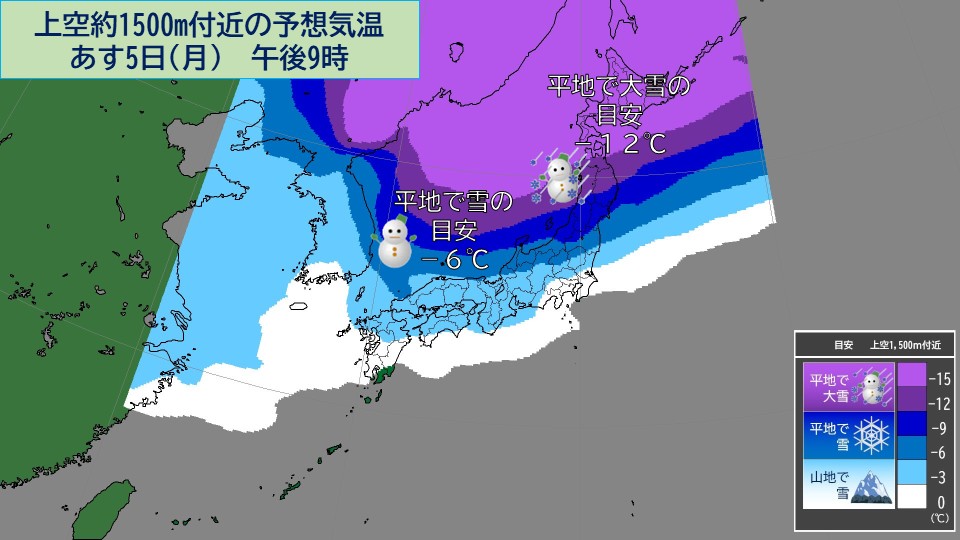
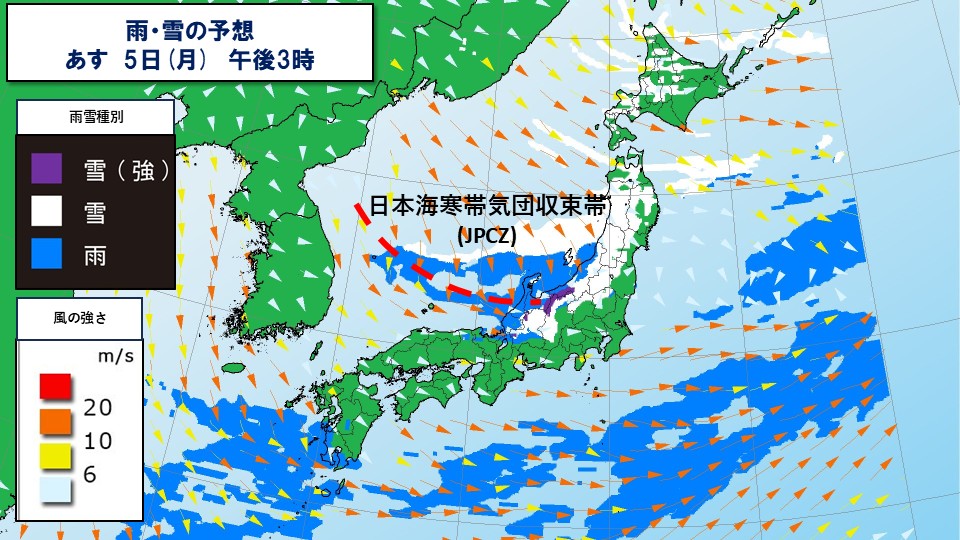
Tomorrow, the 5th (Monday), strong cold air in the upper atmosphere will move southward near Honshu through the night, strengthening the winter-like pressure pattern. Over the Sea of Japan, snow clouds that have developed due to the Japan Sea Polar Air Mass Convergence Zone (JPCZ) are expected to gradually move southward from near Hokuriku to the shadow of the mountains.
There will be snow from the Sea of Japan side of northern Japan to Hokuriku and the Sanin area, and there will be places where the snowfall will be heavier.
In western Japan, from Kinki to Kyushu, there will likely be periods of temporary rain due to the influence of a trough in atmospheric pressure.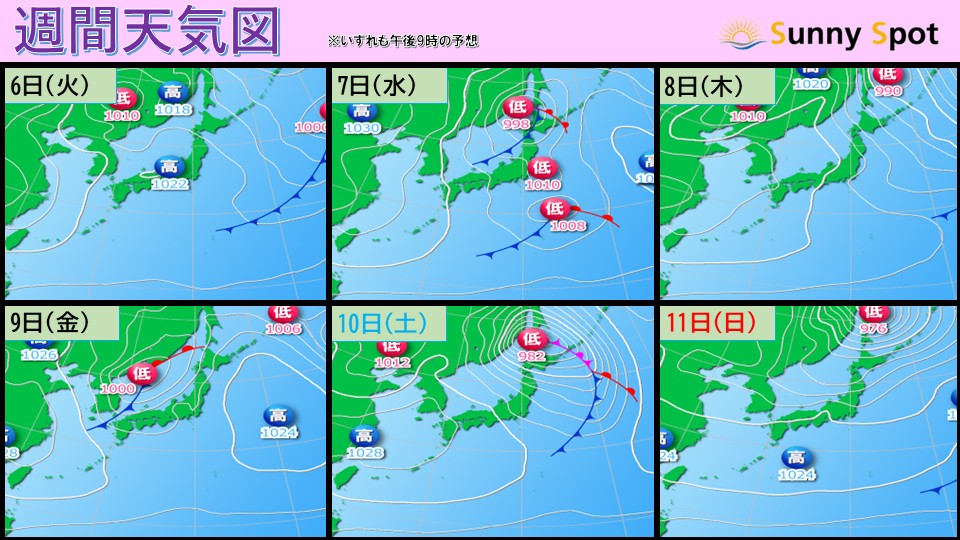
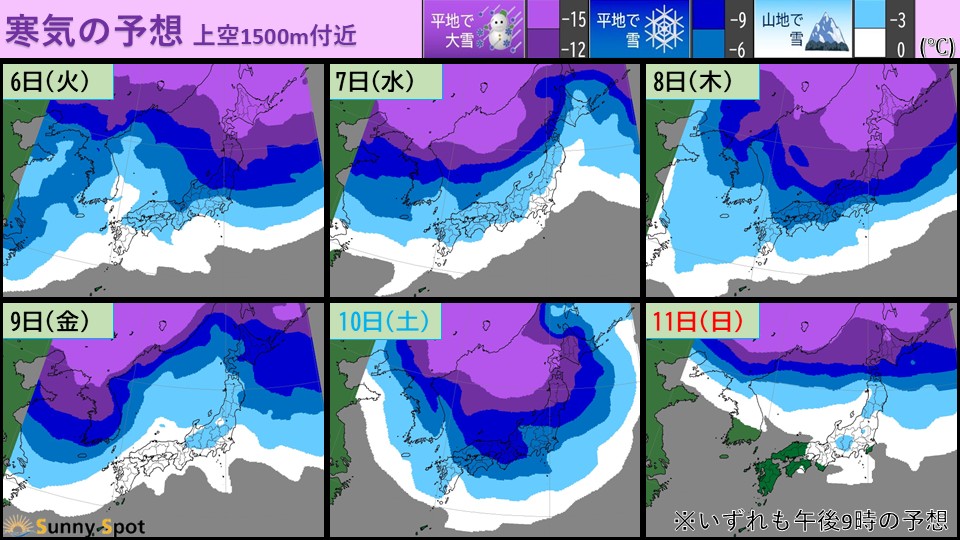
After the 6th (Tuesday), a low pressure system is expected to pass near Japan in short cycles, and strong cold air is expected to repeatedly move south and north around Honshu. After the low-pressure system passes, the strong cold air will move south and the winter-like pressure pattern will become stronger, leading to stronger snow and winds mainly on the Sea of Japan side.
Around the 7th, another low pressure system will form on the Pacific side, and there will be temporary rain in some places. After the low-pressure system passes, strong cold air will move southward, and the winter-like pressure pattern is expected to strengthen on the 8th.Therefore, there will be places where the snowfall will be heavier, mainly on the Sea of Japan side, and winds will also become stronger, causing blizzards in some places.
A new low pressure system is expected to pass near the Sea of Japan around the 9th to 10th, and continue to develop over the 10th before passing near Sakhalin. As a result, there is a risk of rough weather mainly on the Sea of Japan side.
As for the prediction of low pressure, there is a wide range of forecasts at the moment, but please pay attention to the latest weather information that will be updated in the future.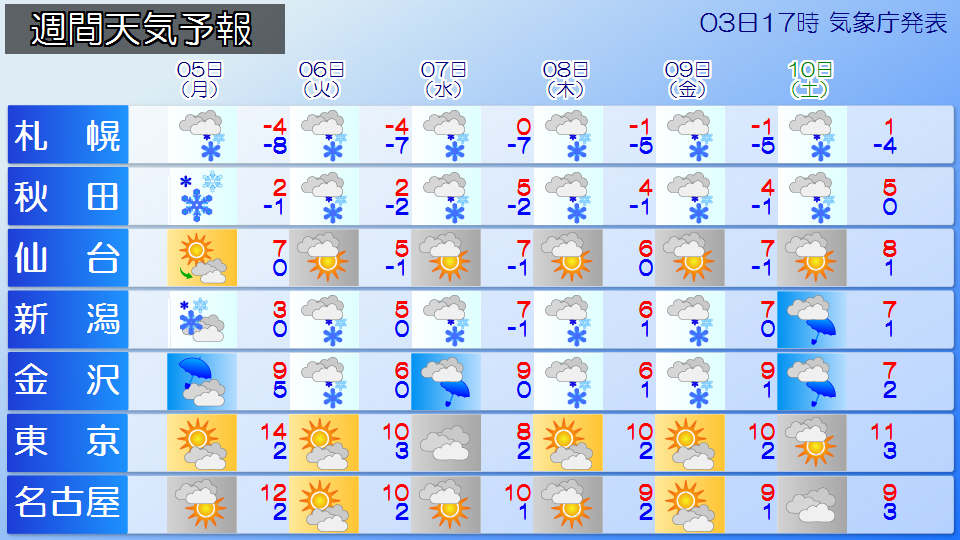

-
Weather on the last day of the New Year holiday: Snow and rain continues from the Sea of Japan side of northern Japan to Hokuriku
2026/01/04 07:14
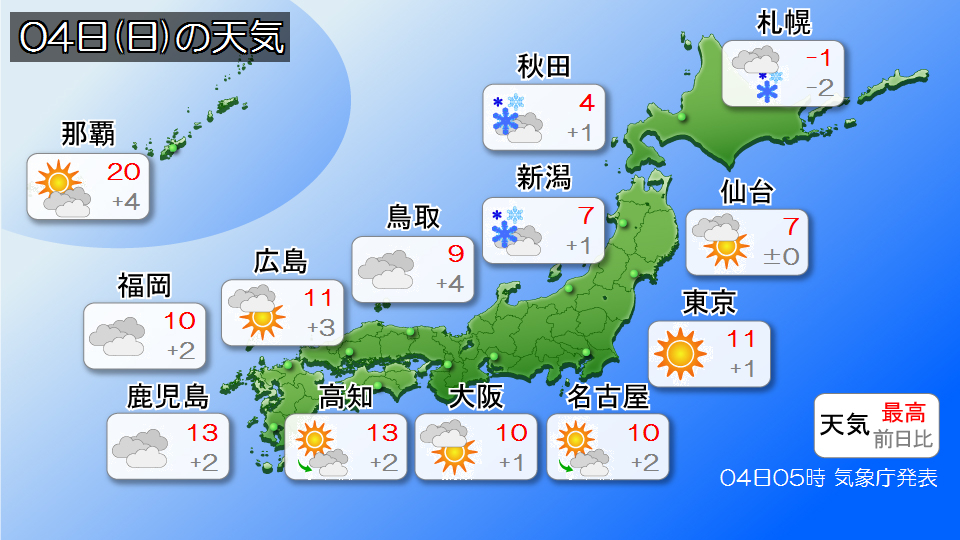
-
Today, the 4th (Sunday), the last day of the New Year's holiday, the air pressure around Honshu will be high in the west and low in the east, centered on northern Japan.
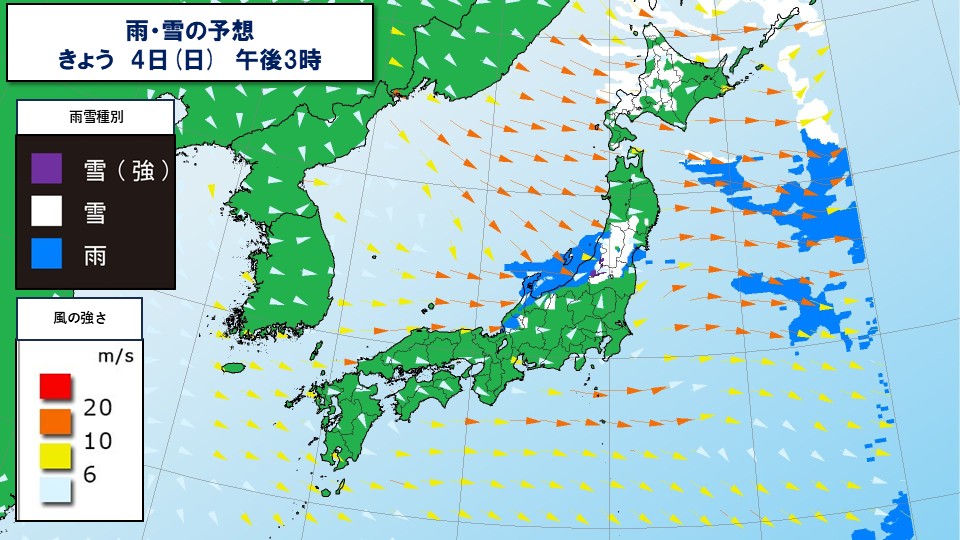
Snow and rain will continue from the Sea of Japan side of northern Japan to Hokuriku. In northern Japan, the isobars are closely spaced and strong winds blow from the west, so it is likely that there will be localized snowstorms. Please be careful of worsening visibility.
Hokkaido is expected to be extremely cold, with many places in the middle of winter with daytime maximum temperatures below 0c. It is essential to take proper measures against the cold.
In Hokuriku, there will be snow mainly along the mountains. In the plains, it is likely to rain for a longer period of time. There is a possibility that the rain will become stronger with localized thunderstorms, and the snow will continue to melt in areas where it rains. Please be careful of deteriorating road conditions, snow falling from roofs, and avalanches.
From eastern Japan to western Japan, there are many sunny places on the Pacific side. The daytime temperature is likely to be slightly higher than yesterday, the 3rd (Saturday), but it will be colder than usual for this time of year. The air tends to be dry, so please wash your hands and gargle frequently to stay in good health.
-
7th (Wednesday) Possibility of snow again in Kanto area. Start of work. What's the weather like this week [Weekly weather]
2026/01/03 12:46

-
#Weather points for the next week#
5th (Monday): Start of work, heavy snow and blizzard on the Sea of Japan side
7th (Wednesday): Low pressure system on the south coast, snow in places on the Pacific side
8th (Thursday): Rough weather in northern Japan
10th (Saturday): Intense cold air flowing westward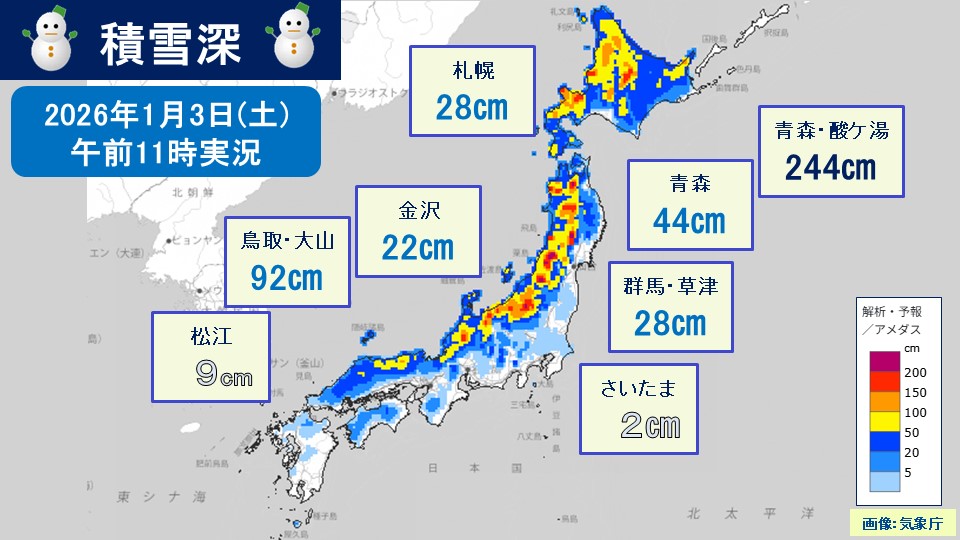
Since yesterday, the 2nd (Friday), heavy snow has been falling on the Sea of Japan side due to a strong winter-like atmospheric pressure pattern.
It also snowed on the Pacific side,
We observed the first snow in Tokyo, Yokohama, Osaka, Kochi, Tokushima, and Kagoshima.
The amount of snowfall in the 24 hours until 11 a.m. is
Niigata Prefecture Itoigawa City Nou 59cm
Hiroshima Prefecture Shobara City Takano 43cm
Gifu Prefecture Ono District Shirakawa Village Shirakawa 41cm
Gunma Prefecture Minakami Town 41cm
Okayama Prefecture Tsuyama City 23cm
Toyama City 27cm
Hiroshima City 3cm
Chiba Prefecture Choshi City 4cm
Tokyo Central 1cm
etc.
Snow from last night remained in central Tokyo, and 1cm of snow was observed until 10 a.m. today.
There are still some places in Saitama Prefecture where snow remains, even on flat areas.
There are places where the roads are frozen even in the daytime, so please continue to be careful of icy roads.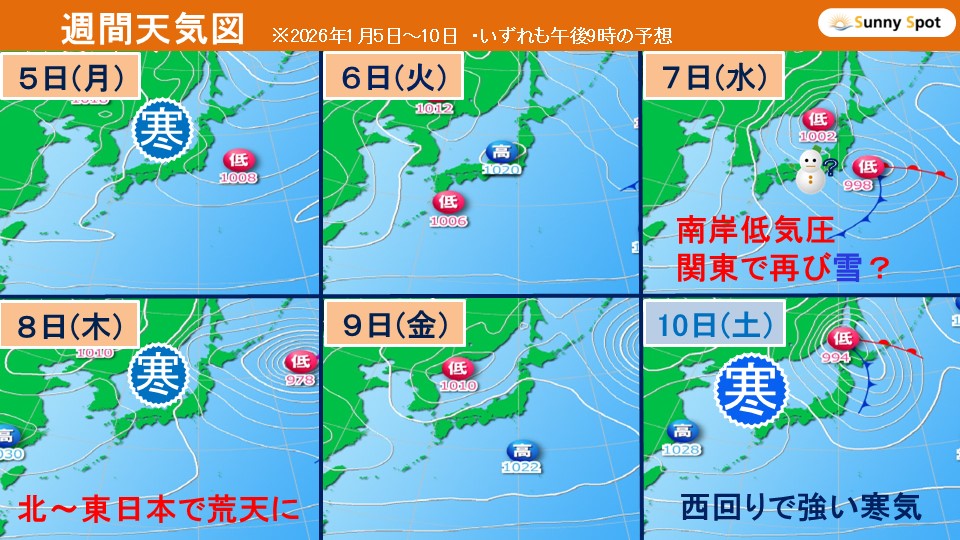
Tomorrow, the 4th (Sunday), high pressure will protrude from the continent and the winter-like pressure pattern will loosen.
It will be sunny in many places in western and eastern Japan, and the snow and rain on the Sea of Japan side of northern Japan and Hokuriku are expected to gradually weaken.
#5th (Monday)#
On the 5th (Monday), strong cold air will flow into the sky again, and
snow and rain will fall from the San'in area to the northern Sea of Japan side.
The wind will be strong and there will be snowstorms in some places.
Also, in Kyushu, it is likely to rain not only on the Sea of Japan side but also on the Pacific side.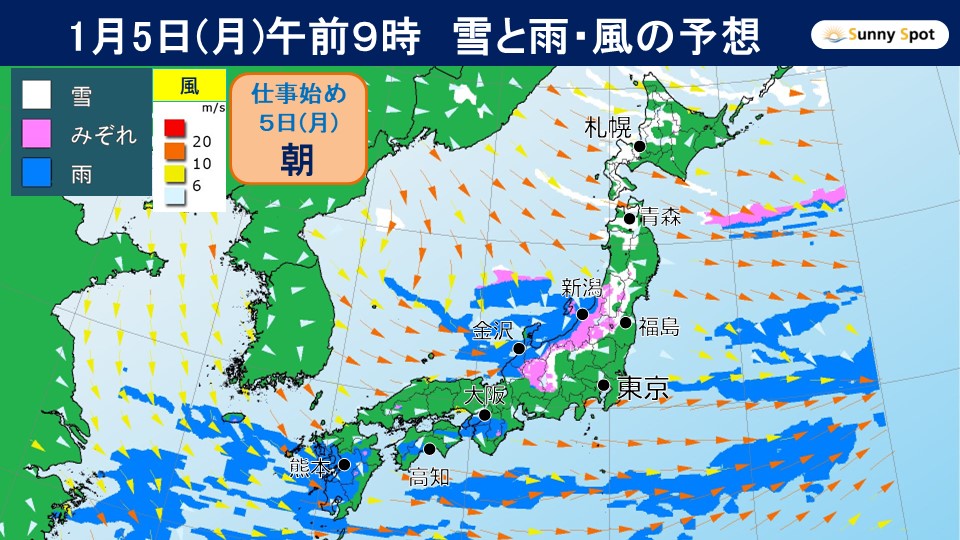
The 5th (Monday) will be the first day of work for many people, but it may take longer than usual due to heavy snow and rain.
It seems better to go out with plenty of time.
#6th (Tuesday)#
It will be covered by a mobile high pressure system, and the strong cold air in the upper atmosphere will temporarily retreat to the north.
It will continue to snow and rain on the Sea of Japan side, but
it looks like there will be many places on the Pacific side where it will be mild and sunny.
#7th (Wednesday)#
Two low pressure systems are expected to pass through the Sea of Japan and the southern coast of Honshu, sandwiching Honshu.
Especially on the 7th (Wednesday), a low-pressure system will move eastward while developing along the southern coast of Honshu, drawing in strong cold air, so there is a possibility of snow, sleet, and rain on the Pacific side of western and eastern Japan as well.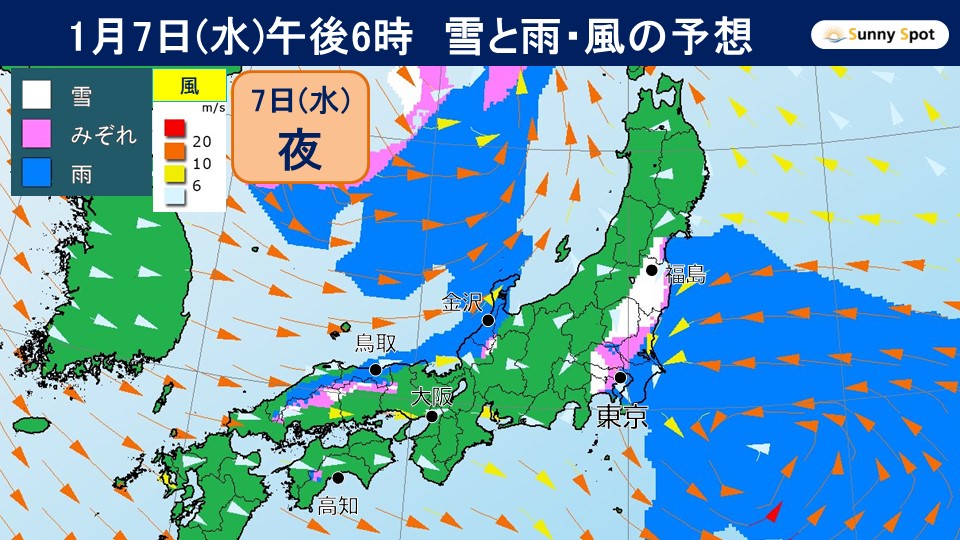
The forecast as of today is that on the night of the 7th,
it will rain in Chiba Prefecture, but there is a possibility of snow in Tama, Tokyo, and western Kanagawa Prefecture, and
snow and sleet in central Tokyo.
However, the timing and amount of snow and rain may change greatly depending on the timing of the passage of the low pressure system and its development.
Please continue to pay close attention to the latest snow information.
#8th (Thursday)#
A low-pressure system is expected to develop as it passes near northern Japan, intensifying the winter-like pressure pattern.
There will be rough weather mainly on the Sea of Japan side of northern and eastern Japan, and depending on the degree of strengthening of the winter-type atmospheric pressure distribution, there is a risk of severe stormy weather.
There is a risk of warning-level storms on the Sea of Japan side of northern Japan and Hokuriku.
#9th (Friday) - 10th (Saturday)#
A low pressure system is expected to advance into the Sea of Japan and continue to develop into the waters near Chishima Island through the 10th (Saturday).
On the 10th (Saturday), the winter-like atmospheric pressure pattern will strengthen, and strong cold air will flow in westward again.
It is expected that snow will fall widely on the Sea of Japan side from the Sanin area to the north, and the cold will continue on the Pacific side as well.
During the first week of work, the weather changes rapidly, the cold weather increases and decreases,
It seems like the temperature and sensation will change drastically from day to day.
Please check the latest weather frequently and take care of your health.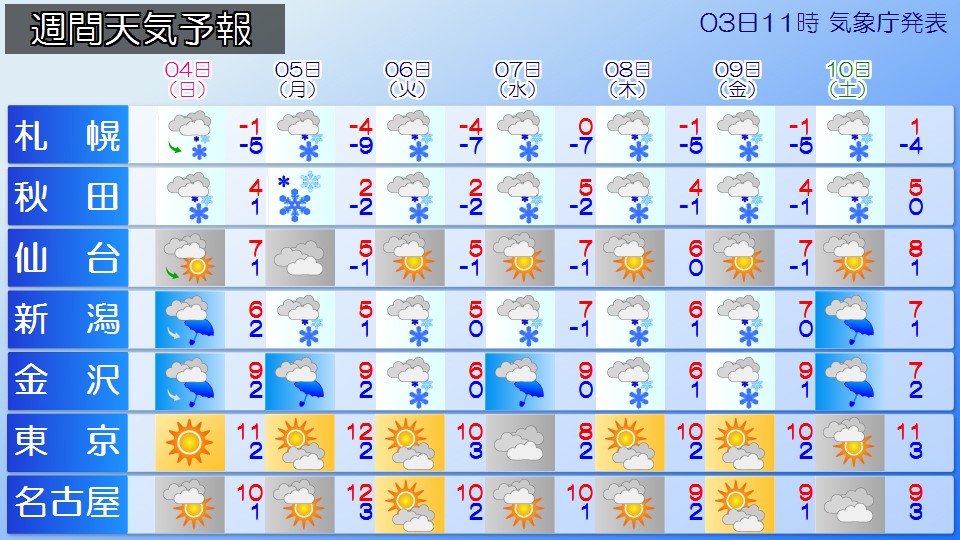
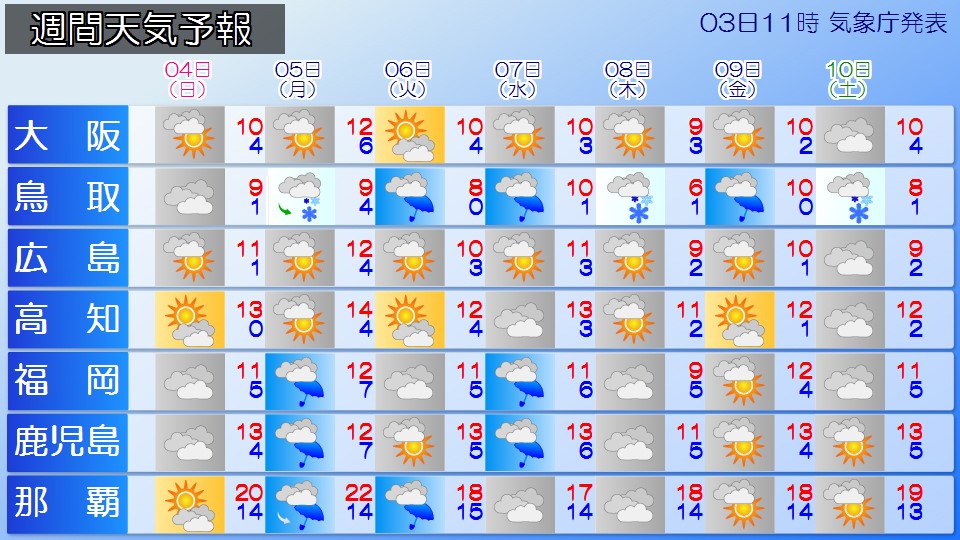
-
Weather for today, the 3rd (Saturday): Heavy snow warning on the Sea of ??Japan side, sunny skies in many places on the Pacific side
2026/01/03 06:22
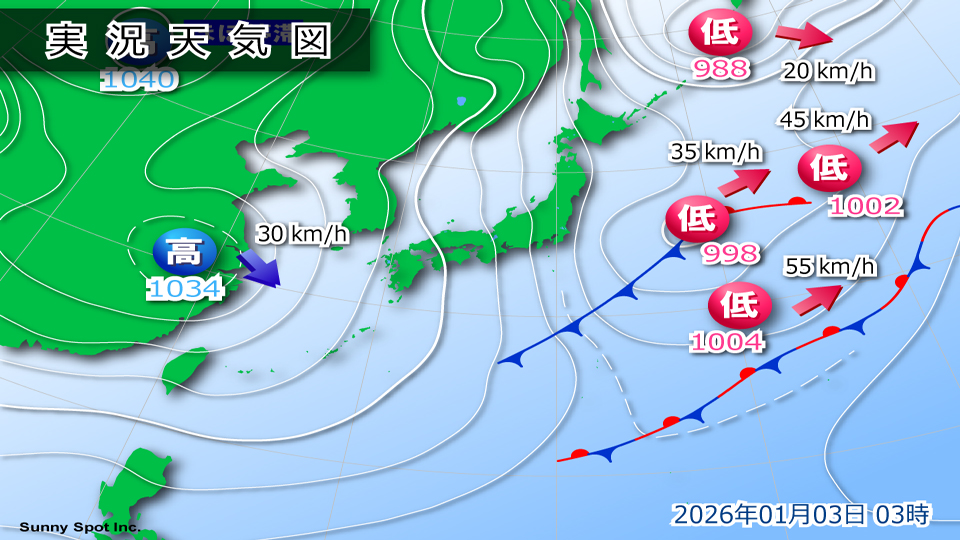
-
Today, the 3rd (Saturday), winter-like atmospheric pressure patterns are expected to continue around Japan. Snow and rain are likely to fall on the Sea of Japan side, and may become heavier in some places. It is expected to be sunny in many places on the Pacific side.
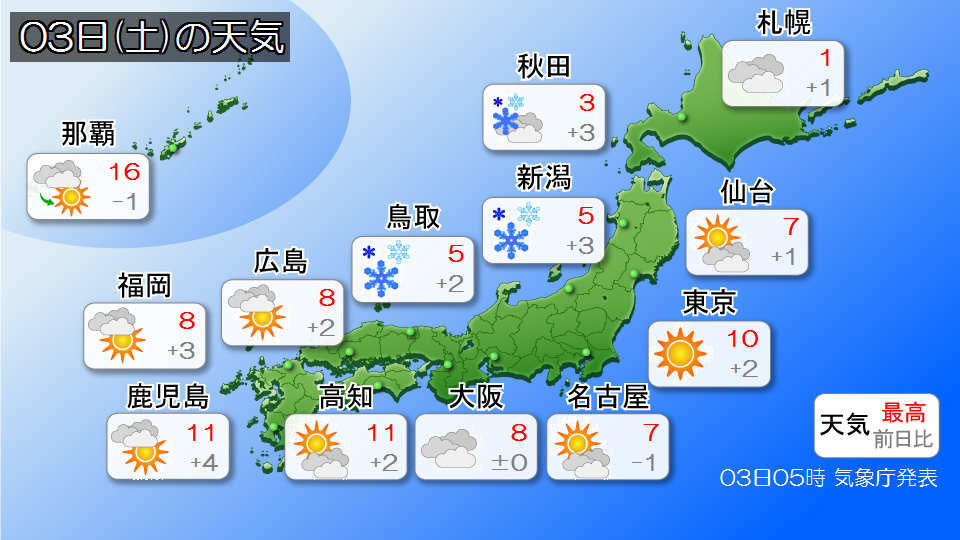
In Hokkaido, clouds tend to spread on the Japan Sea side, and there will be places where there will be light snow showers mainly in the morning and evening. It is predicted that there will be many places on the Pacific side where the sun will reach.
The weather is likely to be prone to snow and rain from the Sea of Japan side of Tohoku to the Sanin area. The snow will become heavier, especially along the mountains, and there is a risk of heavy snow. Please be careful of increased snow accumulation, snow accumulation, and avalanches.
On the other hand, there are many places on the Pacific side where it will be sunny. Please be careful of frozen roads in the morning in areas such as the Kanto region where it snowed last night.
The mid-winter cold continues throughout the day, so please be sure to take adequate measures to protect yourself from the cold.
The sky in Okinawa will be dominated by clouds. There is a possibility of showers in the morning, so it's a good idea to bring rain gear such as a folding umbrella when going out.
-
First snow in Tokyo; observed one day earlier than normal; be careful of frozen roads tomorrow morning
2026/01/02 20:12
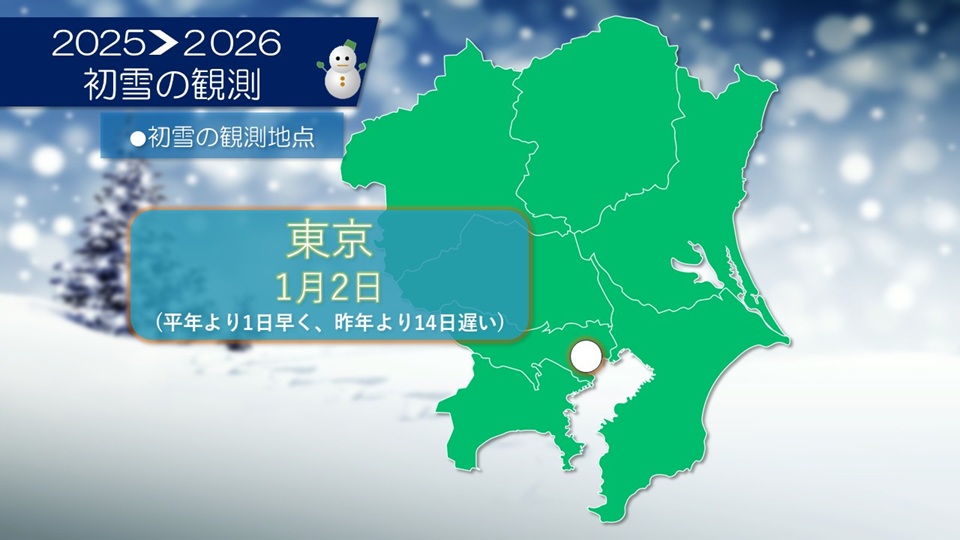
-
Strong cold air below -36c is flowing into the Kanto region at an altitude of 5,500m, causing unstable atmospheric conditions.
At 19:22 on the 2nd, the Japan Meteorological Agency announced that the first snow had been observed in Tokyo. The observation is one day earlier than normal and 14 days later than last year.
It will snow in the Kanto region tonight. By the time the date changes, it has gradually stopped, but as of 7:00 pm, the temperature in Tokyo is 1.0 degrees Celsius, which is getting colder.
Please be careful of icy roads tomorrow morning as there is a risk of wet roads freezing.
-
Strong winter-like atmospheric pressure distribution East Japan - West Japan Sea of ??Japan side to be on alert for heavy snow tomorrow; Kanto region also expected to see snow tonight
2026/01/02 17:44
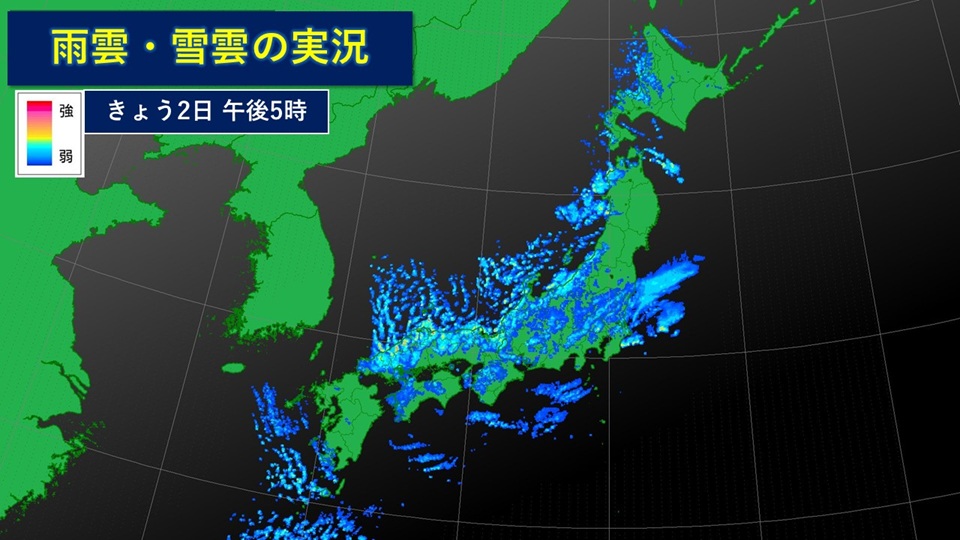
-
The area around Japan has a strong winter-like atmospheric pressure pattern, with a trough extending from the Sea of Japan to the Sea of Japan side of western Japan.
Also, a trough of atmospheric pressure in the upper atmosphere is moving south toward Honshu, and strong cold air with temperatures below -36c is flowing from northern Japan to around 5,500 meters above western Japan. As a result, heavy snow is falling, accompanied by thunder, mainly from eastern Japan to western Japan on the Sea of Japan side, and there are places where heavy snowfall is occurring, including in flat areas.
As of 5 p.m., heavy snow warnings have been issued for Fukui and Yamaguchi prefectures, and heavy snow advisories have been issued for a wide area from Tohoku to Kyushu.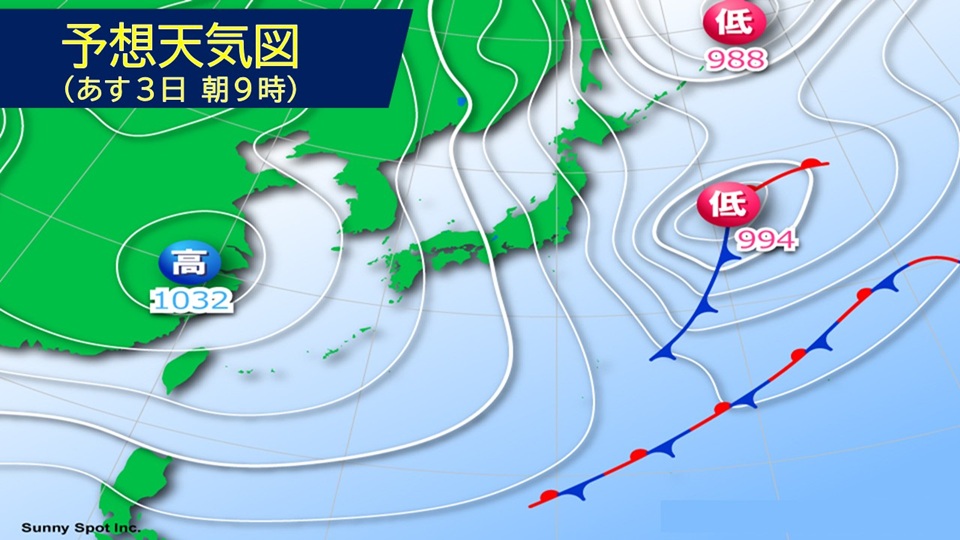
A strong winter-like atmospheric pressure pattern will continue in the vicinity of Japan until the beginning of tomorrow, the 3rd (Saturday), and strong cold air is expected to flow from northern Japan to western Japan. Due to the effects of cold air in the upper atmosphere and a trough in atmospheric pressure, snowfall is expected to increase from eastern to western Japan, mainly on the Sea of Japan side, and atmospheric conditions are expected to become extremely unstable in some places from northern to western Japan.
Also, snow clouds are forming in the Kanto-Koshin region, and there will be heavy snowfall in some places, mainly along the mountains and in the mountains, into the early evening of Saturday the 3rd. Even in the flatlands of the Kanto region, snow clouds are expected to develop tonight, resulting in heavy snow in some places.
In eastern and western Japan, please be on guard for heavy snowfall through tomorrow 3rd (Saturday), and be careful of snow accretion and avalanches. From northern Japan to western Japan, be careful of strong gusts of wind that can cause lightning and tornadoes.
In the Kanto-Koshin region, please be careful of traffic problems caused by snowfall and frozen roads through the early evening of Saturday the 3rd, and be careful of snow accretion on power lines, trees, etc., and avalanches.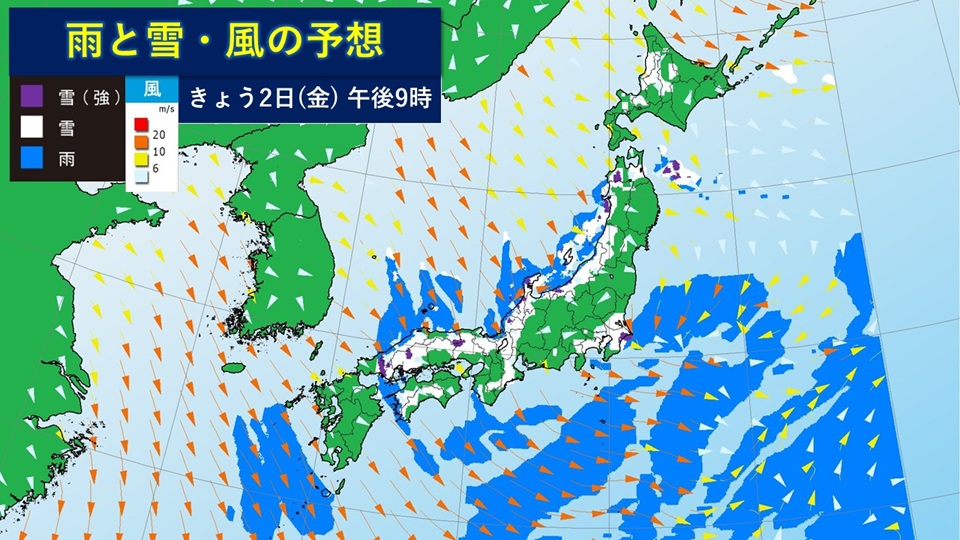

[Snow Forecast]
In eastern and western Japan, there will be areas where warning-level heavy snowfall will occur, mainly on the Sea of Japan side. It is expected that there will be heavy snowfall in some places, even in areas on the Pacific side of eastern and western Japan that usually have little snow.
#Forecasted snowfall (in areas with the most)
+24-hour snowfall expected by the evening of tomorrow 3rd (Sat)
Kanto-Koshin region 50cm
Hokuriku region 70cm
Kinki region 60cm
Chugoku region 40cm
Shikoku region 15cm
Northern Kyushu region 30cm
-
[Is it snowing in the 23rd ward] A change from the New Year's sunny weather. Snow clouds rapidly develop in the afternoon. Be careful of traffic disturbances in Kanto-Koshin for returning home, U-turns, and New Year's visit.
2026/01/02 12:57
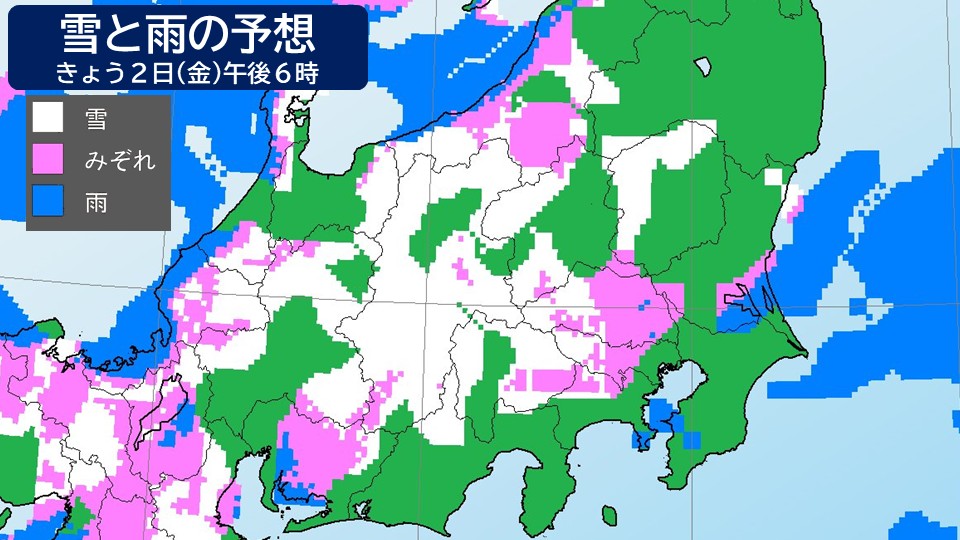
-
Today, the 2nd (Friday), the area around Japan has a winter-like atmospheric pressure pattern, with strong cold air below -36 C at an altitude of approximately 5,500 meters moving eastward near Japan.
In the Kanto region, light snow, sleet, and hail fell in some places from the night of New Year's Day yesterday 1st (Thursday) to the morning of today 2nd (Friday).
As of noon today, Friday the 2nd, the weather has improved in many places.
However, from the afternoon until the morning of Saturday the 3rd, strong cold air with temperatures below -36c at an altitude of approximately 5,500m will flow over the Kanto-Koshin region.
In the Kanto-Koshin region, the difference in temperature between the ground and the sky will increase, and atmospheric conditions are expected to become extremely unstable.
The weather in the Kanto-Koshin region will suddenly change in the afternoon of Friday the 2nd, and snow clouds will form and develop in places in the southern Kanto region, causing snow and rain.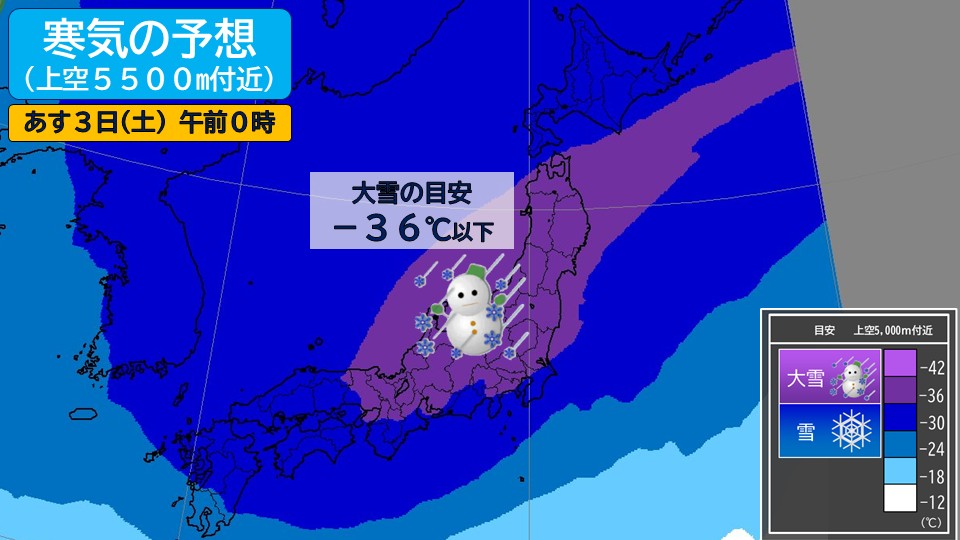
In the afternoon of today (Friday) 2nd, it is expected that snow will begin to fall in some places along the mountains and mountains of the Tama region of Tokyo, Gunma prefecture, Tochigi prefecture, and Nagano prefecture.
After the evening, there will be snow and rain in some places in the southern Kanto region, including Tokyo's 23 wards, Ibaraki Prefecture, and Yamanashi Prefecture.
In the mountains of the Kanto-Koshin region, heavy snow is expected to fall in some places through tomorrow, the 3rd (Saturday).
Even in the flatlands of the southern Kanto region, such as Tokyo's 23 wards, snow will fall temporarily into the early hours of Friday night, the 2nd of today, and there will be places where snow will accumulate on rooftops and lawns.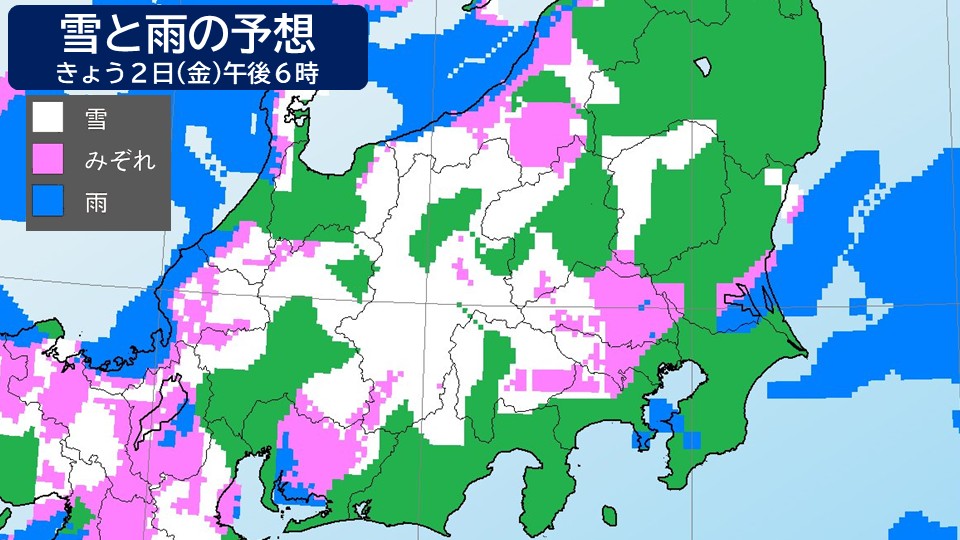
In Nagano Prefecture, if the cold air in the sky becomes stronger than expected or if snow clouds develop more than expected, there is a possibility of warning-level heavy snow.
In the Kanto region, the snow is not due to the ``south coast cyclone,'' which has a pattern of heavy snow, so the possibility of heavy snow is low.
However, when using unfamiliar roads for homecoming, U-turns, New Year's visits, etc., please be careful of snow and frozen roads.
-
Strong cold air, winter-like atmospheric pressure, and warning of heavy snow into the day after tomorrow. Possibility of snow on the Pacific side and Kanto region as well
2026/01/01 18:20

-
There is a low pressure system over the eastern seaboard that is moving northeast.
There is also a low pressure system near Saharin that is moving south.
On the other hand, there is a high pressure system over the continent that extends to the east, and there is a strong winter-like pressure pattern near Japan, with strong cold air flowing into the upper atmosphere.
Currently, there are places where it is snowing and raining on the Sea of Japan coast from Hokkaido to the San'in area, raining in the Amami and Okinawa regions, and heavy snow warnings have been announced in some areas of the Tohoku region.
The strong winter-like atmospheric pressure pattern will continue into tomorrow, the 2nd (Friday), so there will be heavy snow in some places, mainly on the Sea of Japan side.
Atmospheric conditions are expected to be extremely unstable in some places due to strong cold air in the upper atmosphere and a trough in atmospheric pressure, and snow is expected to fall even in areas of eastern and western Japan that usually have little snow.
Be careful of heavy snow and traffic disturbances due to heavy snowfall, and be careful of snow accumulation and avalanches
###Wind forecast
Maximum wind speed (maximum instantaneous wind speed) expected for the day
Hokkaido Northern land on the Sea of Japan side 15 meters (30 meters).
Hokkaido Northern Sea of Japan Sea side 18 meters (30 meters).
Hokkaido Southern land on the Sea of Japan side 15 meters (30 meters).
Hokkaido Southern Sea of Japan Sea side 18 meters (30 meters).
###Snow forecast
From northern Japan to western Japan, there will be places that will experience heavy snow, mainly on the Sea of Japan side.
It is expected that there will be heavy snowfall in some areas of eastern and western Japan that usually have little snow.
The predicted 24-hour snowfall from 18:00 on the 1st to 18:00 on the 2nd is 50 centimeters in the Hokkaido region.
Tohoku Sea of Japan side, along the mountain, 50 cm.
Tohoku Sea of Japan side, flat land, 30 cm.
Tohoku Pacific side, along the mountain, 40 cm.
Tohoku Pacific side, flat land, 30 cm.
Mountains in northern Kanto region 10cm.
Flat land in northern Kanto region 4 cm.
5cm from Hakone to the Tama region and
Chichibu region.
Flat land in the southern Kanto region 1cm.
Koshin region 30cm.
Hokuriku region, along the mountains, 70 cm.
Hokuriku region 40cm.
Northern Kinki Mountains 60 cm.
Northern Kinki Plains 40cm.
Kinki Chubu Mountains 50cm.
Kinki-Chubu plains 10cm.
Southern Kinki Mountains 5 cm.
Sanyo Mountains 40cm.
Sanyo Plain 15cm.
Sanin Mountains 50cm.
Sanin Plain 25cm.
Shikoku region flatland 5cm.
Shikoku region Mountains 15cm.
Northern Kyushu region 40cm.
After that, the predicted 24-hour snowfall from 18:00 on the 2nd to 18:00 on the 3rd is expected to be 40 centimeters in the mountains of the northern Kanto region.
Flat land in northern Kanto region 5cm.
3cm from Hakone to the Tama region and
Chichibu region.
Flat land in the southern Kanto region 1cm.
Koshin region 40cm.
Hokuriku region, along the mountains, 70 cm.
Hokuriku region 30cm.
Northern Kinki Mountains 50cm.
Northern Kinki Plains 40cm.
Kinki Chubu Mountains 40cm.
Kinki Chubu Plain 30cm.
Southern Kinki Mountains 20 cm.
1cm.
Sanyo Mountains 30cm.
Sanyo Plain 10cm.
Sanin Mountains 40cm.
Sanin Plain 20cm.
Shikoku region flatland 5cm.
Shikoku region Mountains 15cm.
Northern Kyushu region 20cm.
###Disaster prevention matters
In Hokkaido,
on the Sea of Japan side, due to the passage of a pressure trough containing a low pressure system, strong westerly or northwesterly winds, accompanied by snow, will blow into the late hours of the 1st.
In addition, heavy snow is expected on the Sea of Japan and western Pacific Ocean sides from late on the night of the 1st to early morning on the 2nd. Please be careful of traffic obstructions caused by blowing snow, snowdrifts, and heavy snow.
Depending on the trend of the low pressure system and the degree of snow cloud development, there is a risk of blizzard or warning-level heavy snow.
On the Sea of Japan side, there is a risk of tornadoes, strong gusts of wind, and lightning strikes into the early hours of the 2nd. Please be careful about outdoor activities and crop management.
If there are signs that a cumulonimbus cloud is approaching, please take precautions such as moving to a sturdy building.
In the Tohoku region, please be on guard for traffic disruptions due to heavy snowfall, snow falling from roofs, and damage to buildings and agricultural facilities late into the evening of the 1st.
After that, please be careful of heavy snow until dawn on the 2nd.
Also, be careful of snow accretion and avalanches on power lines and trees.
On the Sea of Japan side of Tohoku, please be careful of tornadoes and other strong gusts of wind and lightning from before noon on the 2nd until late at night.
If there are signs that a cumulonimbus cloud is approaching, please take precautions such as moving to a sturdy building.
In the Kanto-Koshin region, from the afternoon of the 2nd to the 3rd, please be careful of traffic disruptions due to snowfall and frozen roads, and be careful of avalanches.
Also, in the Kanto region and Izu Islands, from the evening of the 2nd to the beginning of the 3rd, please be careful of thunderstorms, tornadoes, strong gusts of wind, and sudden heavy rain.
If there are signs that a cumulonimbus cloud is approaching, please take precautions such as moving inside a building.
There is also a risk of hail, so please be careful about managing crops and agricultural facilities.
In the Hokuriku region, please be aware of traffic disruptions due to heavy snow over the 3rd.
Houses that were damaged in the 2020 Noto Peninsula Earthquake need to be careful about collapse due to the weight of snow.
Also, please be careful of thunderstorms, tornadoes, and other strong gusts from the afternoon of the 2nd to the 3rd.
If there are signs of a developing cumulonimbus cloud approaching, please take every precaution to ensure your safety, such as moving inside a building.
There is a risk of hail, so please be careful when managing crops and agricultural facilities.
If snow clouds develop more than expected in the Kinki, Chugoku, Shikoku, and northern Kyushu regions from the morning of the 2nd to the morning of the 3rd, there is a possibility of warning-level heavy snow.
Please be careful of traffic obstructions due to snowfall and frozen roads.
Be careful of snow accretion on power lines and trees, avalanches, strong wind gusts such as tornadoes, and lightning strikes.
Please be careful as there is a risk of the plastic greenhouse collapsing.
Please be careful not to approach simple structures such as carports or dilapidated structures as they may collapse.
If there are signs that a cumulonimbus cloud is approaching, please take precautions such as moving inside a building.
Please be careful about crop management.







